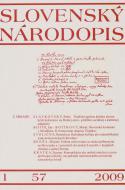Kulinárna kultúra ako identifikačný znak dolnozemských Slovákov
Culinary Culture as an Identification Sign of the Slovaks from the Dolna Zem
Author(s): Rastislava StoličnáSubject(s): Anthropology
Published by: Ústav etnológie a sociálnej antropológie Slovenskej akadémie vied
Keywords: Slovak minorities; culinary culture; social and spatial identity;
Summary/Abstract: The term Dolná zem (”Lower Land”) refers to a geographical region extending to the south of the Slovak-Hungarian ethnic boundary, covering areas in modern Hungary, Serbia, Croatia and Romania. This territory began to be colonised towards the end of the 17th century by people arriving from various European countries, including the Slovaks. The objective of a number of ethnographic studies carried here over the past years has been to map various phenomena of traditional culture in the environment of Slovak minorities. They have yielded evidence that part of the cultural heritage is shaped by a specific culinary culture. This phenomenon was discussed in this study with an ambition to disclose correlations between characteristic signs – symbols of alimentation, on the hand side, and the conditions of life and spiritual contexts, on the other, as well as to detect ”the language of alimentation” typical of the Slovaks settled in the ”Lower Land”. In this region white bread appears to be a characteristic symbol of both cooking and a properly set table. The people here consume bread together with meat, salami, sausages, bacon, soup, sauces and even with pasta. It is not unusual to eat bread as accompaniment to fresh paprika or tomato nor is it surprising to have bread and fruit, such as melon, grapes, plums and sour cherries. The Slovaks settled in the ”Lower Land” have enriched their culinary culture by new dishes. For instance, they prepare various kinds of porridge or groceries from corn flour, which was something entirely unknown to their ancestors in Slovakia. These novelties may be best exemplified by paprika, well-known in a wide variety of sorts. It is eaten fresh, pickled, dried and also added to many dishes as a seasoning. Another symbol of the territorial diet is sarma – rolls of cabbage leaf stuffed with a mixture of minced meat and rice. Among meat products typical of the territory there are klobásy (sausages). The art of sausages production was introduced into the region by the Slovaks. This fact is mentioned even in the Hungarian literature on styles of cooking. In households here, sausages are considered as delicacy – a choice culinary product served to guests to honour them; they are also frequently presented as a gift if the family wants to show respect to someone. An important position in the culinary culture of Slovaks settled in the ”Lower Land” is occupied by alcoholic beverages – wines and spirits: the more to the south the greater the variety of sorts and the higher consumption of these drinks. Some of the spirits distilled from grapes, wines, mulberries and corn cannot be found in Slovakia. Considering the production and consumption of wine it is necessary to point out that this was absolutely unknown to the Slovaks arriving in the ”Lower Land” from mountainous regions in Slovakia. That they have made it a new component of their culture after their arrival in new seats may be regarded as an example.
Journal: Slovenský národopis
- Issue Year: 57/2009
- Issue No: 1
- Page Range: 44 - 59
- Page Count: 16
- Language: Slovak

